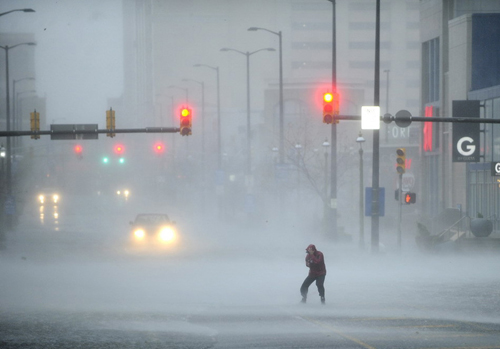Hurricane Sandy just a prelude to an era of extreme weather
- By Dan Steinbock
 0 Comment(s)
0 Comment(s) Print
Print E-mail Shanghai Daily, November 1, 2012
E-mail Shanghai Daily, November 1, 2012
Hurricane Sandy may not have been an anomaly, but a prelude to our extreme weather future.
On Tuesday morning, New Yorkers woke up to near-catastrophic damage. As of afternoon, Hurricane Sandy had killed more than 10 people in the city alone. Some 8 million were without power.
Hurricane Sandy's devastating potential forced US stock markets to close for two days on Monday and Tuesday. It was the first weather-related two-day shutdown since the Great Blizzard of 1888.
As the Northeast began to pick up the pieces of Hurricane Sandy, which disrupted millions of lives on the East Coast, the media spoke of the "once-in-a-generation storm."
In early September, I was in Bowling Green, minutes away from Wall Street, when the sky turned ominously dark. Not long thereafter, a tornado ripped through a beach club in Queens. It was just one of several outbursts of severe weather across the New York region that flooded roads, and felled power lines.
A year before - in August 2011 - I stepped out from a lower Manhattan subway, when a rare earthquake" centered in Virginia rattled parts of New Jersey and New York, causing buildings to sway in cities and towns across the region.
Days later, a state of emergency was declared in New York as Hurricane Irene approached the Big Apple, as a very large and destructive tropical cyclone.
Preparing for the worst, the city shut down the subway system and ordered the evacuation of 370,000 people. As the hurricane weakened to a tropical storm, it spared the city.
According to the recent special report of the Intergovernmental Panel on Climate Change (IPCC), the mean sea level rise is likely to contribute to upward trends in extreme coastal high water levels in the future.
Coupled with the likely increase in very high maximum wind speed, increased and extremely high coastal water levels are no longer a challenge only for small tropical island states, but for large coastal megacities with exceptionally dense urban habitation.
Committed to a green future, New York Mayor Michael R. Bloomberg has encouraged research on climate change. His administration has expanded wetlands to accommodate surging tides, installed green roofs to absorb rainwater and urged property owners to move boilers out of flood-prone basements.
But environmental awareness is not enough to counter the potential for catastrophic flooding. For years, scientists have been warning that, with higher seas, a common storm could prove as damaging as the rare big storm or hurricane is today.
Last year, a study commissioned by New York State concluded that, if sea levels would rise four feet by the 2080s, a third of New York City's streets could lie in the flood-risk zone, compared with a tenth today. Unlike New Orleans, New York City is above sea level. However, the city is second only to New Orleans in the number of people living less than four feet above high tide.
As oceans have warmed and expanded, the waters surrounding New York City rose about an inch over the last century. With increasing climate change, that rate is accelerating. By 2050, these levels are expected to climb two feet higher than today.
More frequent flooding could become the new normal.
I divide my time between New York City and Shanghai, while often traveling worldwide.
In the past decade, I have addressed government agencies, trade associations and business groups on the win-win opportunities associated with the rise of large emerging economies and the concomitant risks of climate change, across several continents. In retrospect, it is almost uncanny how recent our awareness of these threats is and how exposed we still are against such challenges which will accelerate in the coming years.
Of course, "chance" may have accounted for the bulk of Sandy's devastation. However, human-induced global warming has been raising the overall temperate of the surface ocean significantly since the 1970s, while the loss of sea ice is now altering the flow of our atmosphere.
In its new report, the IPCC warns that, by 2070, some of the greatest urban centers will also have the greatest population exposure to coastal flooding, including Mumbai and Kolkata, Shanghai and Guanzhou, as well as Dhaka, Ho Chi Minh City, Bangkok, Rangoon, and Miami.
The inconvenient truth is that the devastation we have witnessed in New York City will not stay just in New York City.
Hurricane Sandy is not a once-in-a-generation storm. It is the prelude to our era of extreme weather events. Tomorrow we shall all be New Yorkers.
Dr Dan Steinbock is research director of international business at the India, China and America Institute (USA) and a visiting fellow at the Shanghai Institutes for International Studies (China)







Go to Forum >>0 Comment(s)